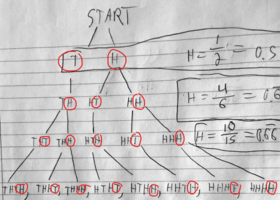Question: flip a fair coin. If tails, your next flip is guaranteed to be heads. If heads, your next flip is fair. If you flip this coin an arbitrarily large number of times, what portion of your flips are heads?
First, I know that the answer must be greater than 0.5; even if we get tails on every fair flip, the number of heads will never drop below 0.5. But beyond that I'm not sure how to approach this problem. I drew a tree below, showing the number of heads on each flip. It seems to approach 0.7, but I don't know how to prove that algebraically.
First, I know that the answer must be greater than 0.5; even if we get tails on every fair flip, the number of heads will never drop below 0.5. But beyond that I'm not sure how to approach this problem. I drew a tree below, showing the number of heads on each flip. It seems to approach 0.7, but I don't know how to prove that algebraically.



